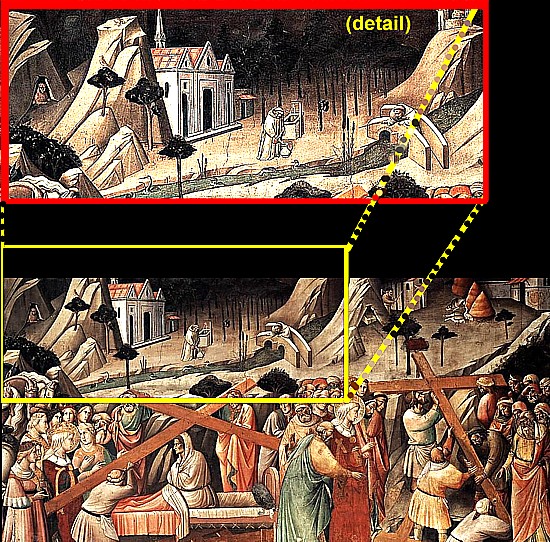 |
| The First Snow, Korpilahti, 1928, Akseli Gallen-Kallela |
There was a time, up until about ten years ago, that I was only interested in American art. Having taught some art history I was, of course, aware of the big names in European art from several different eras, but as has always been the case, what I didn't know about art far outweighed that which I did know. I have the feeling that's largely the case with most artists, and definitely applicable to virtually everyone else. Even when people go in search of art to cover their own walls, they choose only what they like without much regard for who they might like, or learning to like art with which they're not familiar. There's the old quotation from an art buyer: "I don't now much about art but I know what I like." The retort to that is: "No, you don't know what you like, you only like what you know."
 |
| An important reason I like Akseli Gallen-Kallela's work |
Until about a week ago I didn't know the work of the Finnish painter, Akseli (sometimes called, Axel) Gallen-Kallela. So, of course, there was no way I could "like" his work. Having traveled the Baltic area, I've gained a good deal of appreciation for the art from that region(including Finnish art). Though most of the countries are relatively small, taken as a whole, it's still a HUGE area. Add to that the fact that each country has it's own distinctive culture, history, customs, styles, and tastes in art stretching over four or five centuries in some case. And even though all the factors mentioned above tend to overlap some, there are still a tremendous number of highly skilled artists from each country, both living and dead, to come to know and like (or possibly dislike).
 |
| From nineteen to |
Akseli Gallen-Kallela was born Axel Waldemar Gallén in 1865 near Pori, (southeastern) Finland. Even though his family were Finns, they spoke only Swedish. His father, Peter Gallén, served as the town's police chief and lawyer. As a young child, the boy showed exceptional promise in drawing. At the age of eleven, Axel Gallen was sent to by his father to a grammar school in Helsinki to, essentially, unlearn art. He opposed his son's ambition to become a painter. However when Akseli's father died in 1879, though Axel was only fourteen at the time, he took the opportunity to switch majors--to art.
 |
| The land of Finland |
 |
Madonna (Mary and Marjatta),
Akseli Gallen-Kallela |
With all the rugged beauty to be found in virtually every Scandinavian county, an artist could hardly grow up in Finland and
not become a landscape painter (above). Yet Akseli Gallen-Kallela was primarily a painter of Finnish history, myths, and folklore. After attending drawing classes at the Finnish Art Society during the early 1880s, in 1884 Gallen-Kallela moved to Paris, to study at the Académie Julian. There he married Mary Slöör in 1890 to become the father of three children. The couple spent their honeymoon in East (Russian) Karelia where the artist began sketching and painting preliminary work to be used in romantic paintings of the Kalevala, such as the
Aino Myth triptychs, the first of which was completed in 1889, and a second version in 1891 (both seen below).
 |
| Aino Myth (triptychs), 1889 and 1891, Akseli Gallen-Kallela |
 |
Joukahainen's Revenge, 1897,
Akseli Gallen-Kallela |
In March, 1895, Akseli receiv-ed a telegram telling him his daughter, Impi Marjatta, had died from diphtheria. Her death proved to be a turning point in his career. Until then, his works which had always been romantic, became more aggressive as seen in paint-ings such as
The Defense of the Sampo (below),
Joukah-ainen's Revenge, (left),
Kuller-vo Cursing and
Lemminkäin-en's Mother (both below). I should note that the paintings seen below are relatively mild as compared to others from this period having downright suicidal themes.
 |
Compare these with those of his Romantic period.
(The triptychs and those above them.) |
the Paris World Fair of 1900 secured Gallen-Kallela's stature as the leading Finnish artist. Gallen-Kallela officially changed his name to the more Finnish-sounding Akseli Gallen-Kallela in 1907. In 1909, Gallen-Kallela briefly moved with his family to Nairobi, Kenya, where he painted over 150 expressionist oil paintings. However, after two years he returned to Finland realizing Finland was the source of his main inspiration. Between 1911 and 1913 Gallen-Kallela designed and built a home studio in Tarvaspää, about 10 km northwest of Helsinki. However he spent three years in the early-1920s in the United States, where an exhibition of his work toured several cities. He also visited New Mexico's Taos art-colony to study indigenous American art. Back in Finland, in 1925, Gallen-Kallela began the illustrations for his
Great Kalevala. Unfortunately, the were unfinished when he died of pneumonia in Stockholm on in March of 1931. Today, Gallen-Kallela's studio and home at Tarvaspää have become the Gallen-Kallela Museum (below), which houses some of his works and research facilities.
 |
| Gallen-Kallela Museum, Tarvaspää Finland |

























































